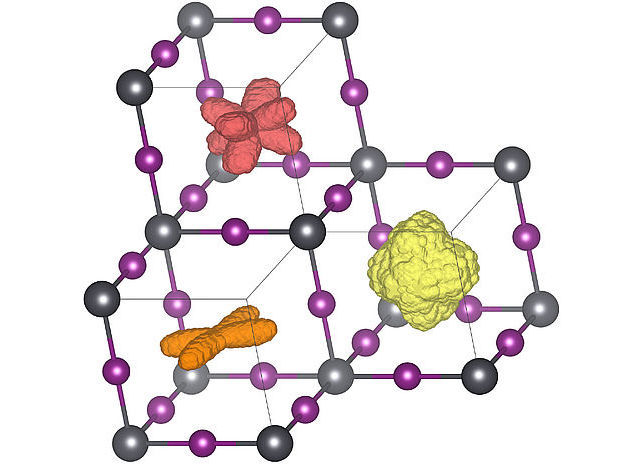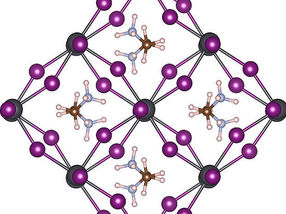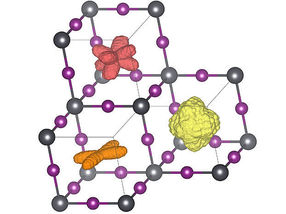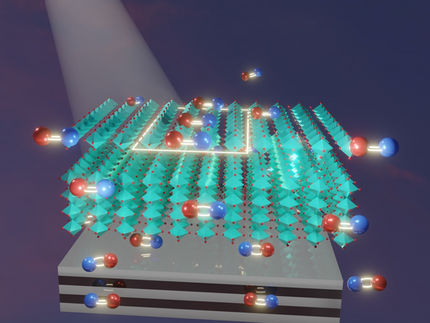Atomic motion captured on-the-fly by machine learning
Advertisement
At the atomic scale materials can show a rich palette of dynamic behaviour, which directly affects the physical properties of these materials. For many years, it has been a dream to describe these dynamics in complex materials at various temperatures using computer simulations. Physicists of the University of Vienna have developed an on-the-fly machine-learning method that enables such calculations through direct integration into the quantum mechanics based Vienna Ab-initio Simulation Package (VASP). The versatility of the self-learning method is demonstrated by new findings, published in the journal Physical Review Letters, on the phase transitions of hybrid perovskites. These perovskites are of great scientific interest due to their potential in solar energy harvesting and other applications.

High symmetry atomic structure of MAPbI3 at room temperature.
© Menno Bokdam/University of Vienna

Three-dimensional distributions of the molecule's orientation in the three different crystal phases. When the temperature is raised (orange→ red→ yellow) the molecules can attain more orientations. The red distribution corresponds to the room temperature structure.
© Menno Bokdam/University of Vienna


At room temperature, all materials are constantly moving at the atomic scale. Even solid rock consists of atoms that swing around. The physical properties of materials are directly linked to the arrangement of atoms in the, so called, crystal lattice. Depending on the temperature or pressure this arrangement can change thereby affecting the materials properties. One can think of diamond, which is transparent and hard because of the periodic arrangement of carbon atoms in the diamond crystal. The same atoms, arranged differently, results in black, brittle graphite. It was already possible to accurately calculate the coordinates of the atoms in simple materials at different temperatures with quantum mechanical molecular dynamics (MD) simulations. However, such calculations are computationally expensive and restrict practical applications to a couple of hundreds of atoms and limited simulation time.
Physicists from the Computational Materials Physics group at the University of Vienna have developed a new approach that overcomes these limitations and makes simulations of complex materials for future energy applications possible. This is achieved developing an efficient and robust data-driven self-learning algorithm and, most importantly, by integrating this algorithm directly into the Vienna Ab-initio Simulation Package (VASP). In the new approach, the “machine” can pick up, on its own, the essential ingredients for a simpler model description of the interacting atoms during MD simulations. Already after calculating a few hundreds of time-steps the machine can predict accurately enough the positions of the atoms in the consecutive time-step. The machine is also able to make an estimate of its accuracy for the consecutive steps. If the error is too high, the machine switches gears and performs the very accurate, but expensive, MD calculations. The more simulation time passes, the more the machine learns and the more precise it becomes. In this way, fewer and fewer MD calculations are required, which eventually leads to the situation where all time-steps are made by the machine. Moreover, the on-the-fly self-learning ability reduces the need for human intervention required by other existing machine-learning methods.
To demonstrate the power of this new method, the researchers have applied it to study the transitions between different atomic structures of the MAPbI3 perovskite upon changing the temperature. This material is very popular because of its potential as a new cheap solar cell component. It is made of organic molecules that can rapidly flip around, separated from each other by a lattice composed of lead and iodide atoms. Depending on the temperature three different crystal phases are formed. The atomic mechanisms near the transition temperature are very difficult to be determined by experiment, and MD simulations would require years of compute time even on a modern super-computing system. After learning, the machine can predict the phase transition temperatures and lattice constants of this material with unprecedented precision. The developed method is general and applicable to many other future materials science problems and will become available for researchers word-wide in the upcoming version of VASP.
































































